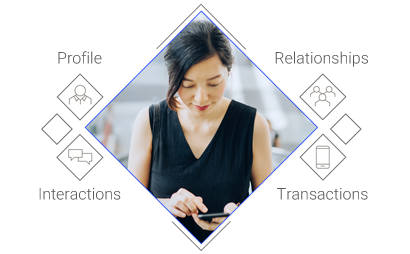
Learn how customer experience software, powered by customer data and supplier information, helps you form accurate customer profiles
Examining the market: Customer experience software
Capturing and sustaining customer loyalty today means constantly raising the bar on customer engagement. Consumers continually expect less friction and more personalization in their interactions with businesses, regardless of channel.
To engage customers at an increasingly individual level, companies need to manage all data about them strategically, end to end, in a way that creates real-time, consistent omnichannel experiences. Data from multiple systems—marketing, inventory, physical stores, web shops, customer service, and more—is then melded together, to create trusted customer profiles and rich product information that power customer experience (CX) software. This forms the foundation of great brand experiences that build ongoing customer relationships.
Customer experience management vs. customer relationship management: What’s the difference?
Two customer experience solutions, customer experience management (CEM) and customer relationship management (CRM), each play a key role in creating or using data to help an organization deliver what customers want and need.
The key difference is that CRM helps you manage what you know about the customer, while CEM helps you develop a deeper understanding of the customer. CRM collects data about how you interact with customers to optimize marketing, drive sales, and improve customer support. CEM uses data to reveal how customers behave across all transactions and interactions, channel experiences, sales conversations, service calls, and so on.
By delivering visibility across the customer lifecycle, CEM helps you better understand customer behavior so you can grow revenue and deliver the convenient, consistent, personalized, relevant experiences that keep customers focused on you and your brand.
Five Customer Experience Use Cases
Great customer experiences start with great data. Let’s look at five CX use cases that represent a few ways that companies can leverage their customer data to sharpen their competitive edge and add value to their business.
Marketing transformation
Facing stiff competition from web retailers and international companies, Kmart Australia Limited realized that retaining its customers meant giving them the digital shopping channels and innovations they crave. A data management solution focused on creating great product data allowed the company to deliver what customers wanted: faster access to new products and greater choice through online channels. Today, Kmart Australia can introduce new products four times faster while increasing online availability from just 6 percent of its product range to 98 percent—and its sales have quadrupled.
More targeted sales
Kelly Services, one of the world’s best-known staffing companies, has two sets of customers: companies with job openings and individuals looking for work. Using a data platform focused on customer data, Kelly Services extracts data from resumes, emails, job descriptions, and video interviews to create rich and accurate profiles of both jobseekers and open positions. Those in turn lead to faster, more relevant matches between talent and opportunity, and ultimately, greater satisfaction for both groups.
Risk, fraud, and compliance
Rent-A-Car, France’s leading company in proximity car rental, invested in technology to build a 360 view of its customers and better understand their needs. In addition to letting Rent-A-Car deliver a seamless rental experience with app-driven self-service options, the solution also pulls together customer data from multiple sources so the company can better spot patterns of behavior that might indicate a renter is a risk for fraud, theft, or unsafe driving.
Personalized omnichannel experiences
PUMA, known for its lifestyle shoes and athleticwear, wanted to provide its customers with a hyper-personalized experience including more accurate product recommendations. By adopting a data-centric solution that incorporates machine learning to better match disparate records into a single view, PUMA gained a far more granular understanding of its products and individual customers—and used that understanding to boost sales significantly enough to achieve its ROI goals in less than two years.
Next best actions and experiences
Santalucía Seguros, a leading Spanish insurance company for more than a century, is responding to customer demand to do business through digital channels by undergoing an enterprise-wide digital transformation. Investing in a CX solution has let the insurer shift from a policy-centric approach to one that enables personalized next best offers by connecting customers and products across all its lines of business: home, life, financial, retirement, pet, and more.
How do I get started with customer experience software?
The first step in extracting maximum value from your customer data is to tackle data challenges such as data quality, data access, and data governance. Customer experience software allows you to:
Create a trusted foundation of customer data
Collect additional information from interactions
Connect information to customers individually so you know who is doing what
Analyze the data so you better understand your customer
Optimize your business processes accordingly
You need to be certain that your customer data is fit for use and able to address your near- and long-term business requirements. That’s the best way to ensure that your investments in a CX ecosystem deliver a solid ROI and move you toward your strategic goals.
Additional customer experience resources
eBook: Build a Better Customer 360
Blog: Want to offer exceptional customer experience? Ask your data
Webinar: Personalized Customer Experience for the Modern Digital World




